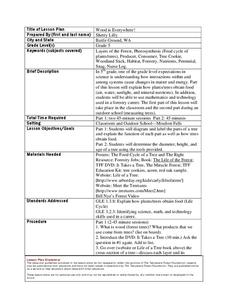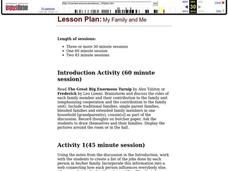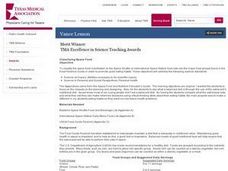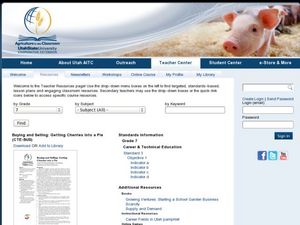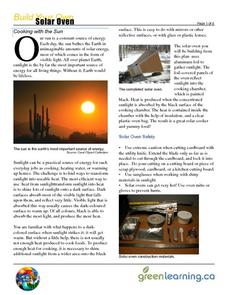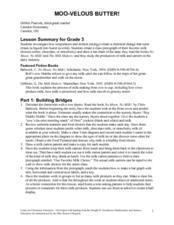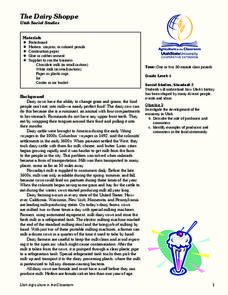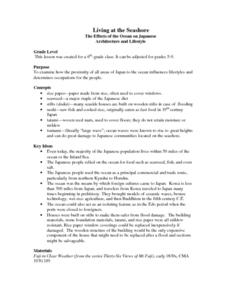Howard Hughes Medical Institute
Survival of the Fittest - Variations in the Clam Species Clamys sweetus
It's not often that you come across a clever laboratory activity that is both imaginative and comprehensive! Using M&M's and Reese's peanut butter candies to represent two different clam species, young biologists test for "relative...
Curated OER
It's In the Numbers
High schoolers explore the careers available in the field of oceanography. They discover the difference between a job and a career and the need for a good education. They work together to create a presentation about oceanography.
Curated OER
Choosing a Career in Health
Students describe the role of hand washing in prevention of disease transmission, explore various careers in the health field, and describe a health career that is of interest to them, and explain why.
Curated OER
Cranes, Crosswalks, and Big Gulps
Students watch a video and answer questions based on wildlife jobs. In this wildlife lesson plan, students learn that biologists don't just play with animals but that there is a lot of study involved.
Curated OER
Wood is Everywhere!
Fifth graders diagram and label the parts of a tree. For this lesson plan on how trees obtain food, 5th graders diagram and label the parts of a tree, and determine the diameter, height, and age of a tree.
Curated OER
Let’s Make Cottage Cheese
Young scholars watch the process of making cottage cheese from milk, then season and taste the product. In this making cottage cheese instructional activity, students make a connection between what they eat and where it came...
Curated OER
Trees at Work... Just Look!
Pupils investigate the significance of trees. They collect magazine pictures of animals that live in trees, list products that are made from trees, collect twigs and create an item using the sticks, and bring in and discuss food from trees.
Curated OER
The Structure And Functions of Proteins
Ninth graders investigate the structure of proteins and how it affects their function. They build a protein model with four helix units and describe how this structure aids the protein in doing its jobs.
Curated OER
My Family and Me
Students discuss the family unit and compare it to an ant colony. In this family instructional activity, students draw their family and extended family and talk about their jobs and family roles. They compare this to an ant colony...
Curated OER
BUS: Farming: It's A Fact (Ag)
Students create two different types of graphs from the information in the "Farm Facts" booklet (i.e., bar graph, pie chart, etc.). They calculate where your food dollars are spent (on and off farm).
Curated OER
The Gifts of Trees
Young scholars examine the various things trees give us. They read the book, "The Giving Tree" by Shel Silverstein, cook a food using a tree fruit, create notepads using unused paper, construct a picture frame with twigs, and write a poem.
Curated OER
Classifying Space Food
Students write a written summary of what they have learned about the astronaut nutritional diet in comparison with their own diet habits.
Curated OER
Listening To The Prairie
Students investigate the concept of agriculture and how it is part of the ecology and economy of the United States. They participate in a number of different classroom activities intended to raise agricultural awareness. The activities...
Curated OER
Buying and Selling: Getting Cherries into a Pie
Kids keep score as they take on the roles of buyers and sellers in an agribusiness introduction. They play the game for five rounds, each round is made different by having a new economic element added, a discussion follows. Everything...
Green Learning
Build Your Own Solar Oven
This is not exactly a lesson plan, but rather a six-page document detailing how to build a solar oven. A bit of background information, materials list, diagrams and photos, and clearly-written procedures are all included. There are no...
Curated OER
Moo-Velous Butter!
Third graders investigate how temperature and motion (energy) create a chemical change that turns cream ( a liquid) into butter (a solid). They create a class pictograph of their favorite mils choices (white, chocolate, or strawberry)...
Curated OER
When I Was Young In Appalachia
Students comapre and contrast the lifestyles of the people of the Applachian region with their own community through in-class discussions, creative projects, hands-on activities, food preservation, homemade remedies, home construction,...
Curated OER
The Dairy Shoppe
Fifth graders research dairy farming and learn about dairy products as well as dairy processing. In this dairy lesson, 5th graders read background information about dairy farming and processing. Students discuss running a small business...
Curated OER
How to: Build a Plant Cell
Students build a 3-dimensional model of a plant cell with household objects. In this plant biology lesson plan, students construct replica plant cells in groups of three. After completing their projects, students share their creations...
Curated OER
fun with Plants that We Use
Students become familiar with the products made from various plants. For this plants lesson, students experiment with natural dyes from plants. Students complete a list of things made from plants. Students answer...
Curated OER
A Day in the life of...
Students read about and study insects--their distinguishing characteristics, habitats, camouflage methods, defense mechanisms, etc. They draw pictures and write a story from the viewpoint of an insect and share their pictures and stories...
Biology Corner
Cell Theory Rap
All that this will link you to is a rap about cell theory and organelles. Use it as an example for a creative assignment in your biology class. Divide the class into groups and assign them a topic for which they write and perform a skit,...
Curated OER
Honduras Finding the Top Bananas
Eighth graders complete an online scavenger hunt about banana cultivation before they visit a grocery store to examine banana products. They investigate "certified" means in relation to banana production and read the "Rainforest Alliance...
Curated OER
Living at the Seashore
Students examine how the proximity of all areas of Japan to the ocean influences lifestyles and determines occupations for the people. This lesson includes lesson extensions and a concept list.




